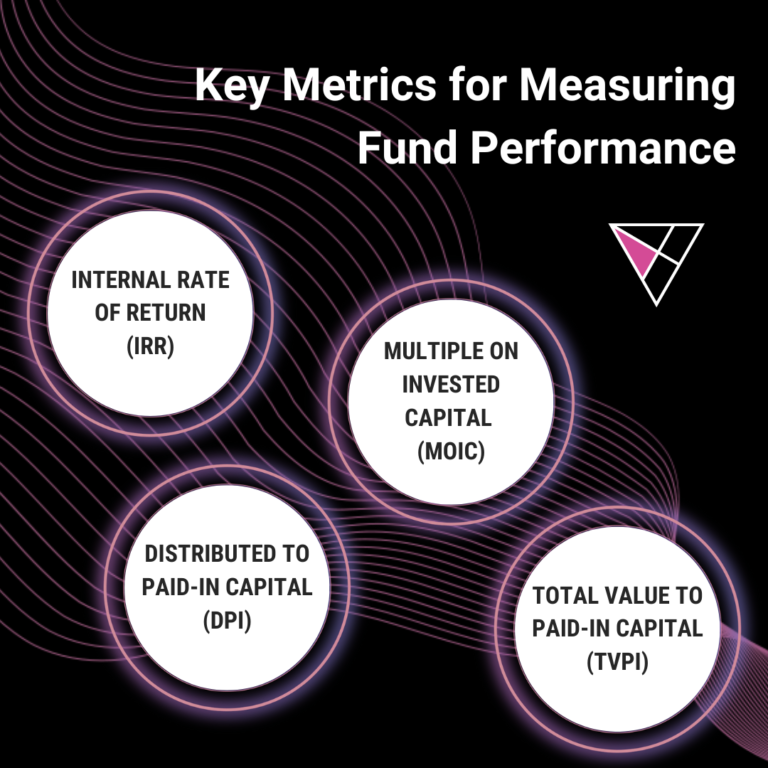Private Equity and Venture Capital firms deploy investor’s funds into high-risk, high-reward startups, hoping to hit the jackpot when these companies eventually exit either through a sale, M&A or an IPO. But how do we evaluate the performance of a fund? In this blog post, we’ll unpack some of the key metrics used to measure and compare the effectiveness of funds.
Internal Rate of Return (IRR)
When it comes to assessing the performance of any investment, the Internal Rate of Return (IRR) is one of the most commonly used metrics. The IRR is a calculation used to estimate the profitability of potential investments.
In the VC/PE world, you will often come across two variations of IRR: Gross IRR and Net IRR.
Gross IRR is the internal rate of return before fund expenses, management fees, and carried interest are subtracted. It represents the fund’s return solely based on investment performance. Broadly, Gross IRR paints a clear picture of how “good” a manager is at picking investments. However, Gross IRR can paint an overly optimistic picture of a fund’s performance since it doesn’t take into account the previously mentioned expenses that will reduce investor returns.
Net IRR, on the other hand, is the IRR that takes into account fund expenses, management fees, and carried interest. The Net IRR percentage provides a more comprehensive return received by Limited Partners than the Gross IRR percentage. This is generally the figure that investors will pay most attention to because it shows the performance of their invested capital.
In the context of funds, it’s not uncommon for the IRR (particularly the Net IRR) to be negative in the early years, due to the high upfront costs of investing in startups (often referred to as a J-curve when depicted on a graph). However, a strong exit can turn the IRR positive, which is why patience is often a virtue in VC investing!
Multiple on Invested Capital (MOIC)
Another essential metric is the Multiple on Invested Capital (MOIC). This figure is calculated by dividing the total returns (both realized and unrealized) by the amount of the initial investment. This metric can be nicknamed the “bang for your buck metric”. If MOIC for an investment is greater than 1x, that means that the investment has generated a return greater than the money that was invested. The higher the MOIC the better!
Distributed to Paid-In Capital (DPI)
The Distributed to Paid-In Capital (DPI) ratio measures the distributions that have been returned to LPs from an exit/realized event. DPI is calculated by dividing the cumulative distributions to investors by the total capital called from investors. It’s a vital measure for Limited Partners because it shows the actual cash returned to them rather than paper returns (unrealized gains).
Total Value to Paid-In Capital (TVPI)
While DPI shows how much capital has been returned to investors, the Total Value to Paid-In Capital (TVPI) ratio accounts for both the distributed and remaining value of the fund. TVPI is the sum of Distributed Capital and Residual Value (estimated current value of investments still held by the fund) divided by the total capital contributed to the fund. The TVPI gives a comprehensive view of the fund’s performance, providing insight into both realized and unrealized gains. Anything greater than 1 is considered a positive return.
Recap
In summary, fund performance measurement is a multifaceted endeavor. The IRR, MOIC, DPI, and TVPI are all crucial metrics to consider. None of these alone can provide a holistic view of a fund’s performance. Instead, they should be used in conjunction to draw a comprehensive picture.
ABOUT VECTOR
Vector AIS is a next-generation fund administrator and technology company for closed-end investment funds.
At Vector, we strive to create an inspiring, inclusive, equitable workplace that celebrates and values employees. As we continue to scale, we do so with a responsibility to foster a culture of inclusivity and balance that allows teammates to thrive at work and in their personal lives.
Join the team, become a client, or follow us as we execute our mission.




